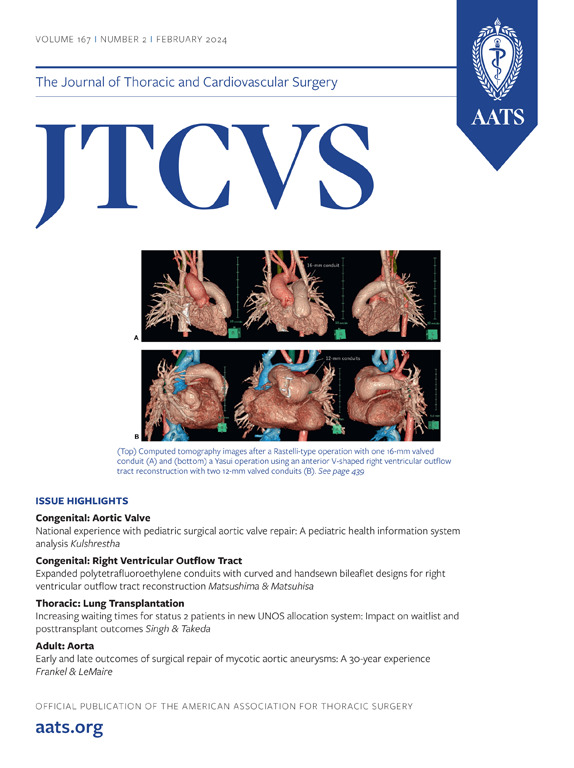CALGB 140503(联盟)的结果显示,淋巴结清扫的程度与大叶或叶下切除术后的无病生存无关。
IF 4.4
1区 医学
Q1 CARDIAC & CARDIOVASCULAR SYSTEMS
Journal of Thoracic and Cardiovascular Surgery
Pub Date : 2025-10-01
DOI:10.1016/j.jtcvs.2025.06.007
引用次数: 0
摘要
目的:c- I期非小细胞肺癌(NSCLC)患者行淋巴结切除术(LAD)的程度存在争议。CALGB 140503(联盟;NCT00499330)将临床期≤2cm的外周1A期NSCLC患者随机分为大叶切除(LR)或大叶下切除(SLR),并对2个纵隔和1个主要肺门淋巴结(简单取样)进行冰冻切片检查,确认无淋巴结转移。在外科医生的判断下进行额外的淋巴结清扫,包括简单取样(S)、系统取样(SS)或完全淋巴结清扫(CLND)。在这里,我们报告了LAD程度对该试验中无疾病和无复发生存(DFS和RFS)的影响。方法:2007年6月至2017年3月,697例患者随机分为LR组(357例)和SLR组(340例)。689例患者的淋巴结切除术程度数据:182例为CLND, 349例为SS, 158例为s。DFS定义为肺癌(LC)复发或全因死亡率的时间。RFS定义为到LC复发或LC死亡的时间。使用Kaplan-Meier法估计生存终点。分层Cox比例风险(PH)模型估计风险比及其置信区间(CI)。结果:两组间基线特征基本相似。CLND后5年DFS为62.3% (95%CI: 55.2 ~ 70.4%), SS后为65.7% (95%CI: 60.7 ~ 71.2%), s后为61.2% (95%CI: 53.7 ~ 69.7%), LR与SLR之间基于淋巴结清扫程度的DFS差异无统计学意义。CLND患者在LR后的5年DFS为65.7% (95%CI: 56.4 ~ 76.6%), SLR后的5年DFS为58.5% (95%CI: 48.2 ~ 71.1%) (p=0.530)。S/SS患者在LR后的5年DFS为63.5% (95%CI: 57.6 - 70.0%), SLR后的5年DFS为65.1% (95%CI: 59.2 - 71.6%)。CLND患者LR后的5年RFS为72.5% (95%CI: 63.5 - 82.9%), SLR后的5年RFS为68.9% (95%CI: 59.0 - 80.5%) (p=0.526)。rs /SS患者在LR后的5年RFS为70.8% (95%CI: 65.0 - 77.0%), SLR后的5年RFS为70.2% (95%CI: 64.4 - 76.5%) (p=0.604)。两组之间在全身复发或孤立的肝门、纵隔或锁骨上淋巴结复发的发生率上没有差异。结论:对于大小≤2cm的外周c期IA型NSCLC患者,如果至少有两个纵隔淋巴结和一个肺门大淋巴结没有淋巴结转移,无论实质切除程度如何,基于淋巴结清扫程度的DFS和RFS没有差异。我们的研究结果适用于通过细致的x线摄影和术中淋巴结分期认为淋巴结阴性的高度选择的患者队列。本文章由计算机程序翻译,如有差异,请以英文原文为准。

The extent of lymph node dissection is not associated with disease-free survival following lobar or sublobar resection: Results from Cancer and Leukemia Group B 140503 (Alliance)
Objective
The extent of lymphadenectomy in patients with c-stage I non–small cell lung cancer is controversial. Cancer and Leukemia Group B 140503 (Alliance; NCT00499330) randomized patients with peripheral clinical stage 1A non–small cell lung cancer 2 cm or less to lobar or sublobar resection after frozen-section examination of 2 mediastinal nodes and 1 major hilar node (simple sampling) confirmed the absence of nodal metastases. Additional node dissection was performed at the surgeon's discretion and included simple sampling, systematic sampling, or complete lymph node dissection. We report the impact of the extent of lymphadenectomy on disease- and recurrence-free survival in this trial.
Methods
Between June 2007 and March 2017, 697 patients were randomized to lobar resection (357) or sublobar resection (340). Data on the extent of lymphadenectomy were available on 689 patients: A total of 182 patients had complete lymph node dissection, 349 patients had systematic sampling, and 158 patients had simple sampling. Disease-free survival was defined as the time to lung cancer recurrence or all-cause mortality. Recurrence-free survival was defined as the time to lung cancer recurrence or death from lung cancer. Survival end points were estimated using the Kaplan–Meier method. Stratified Cox proportional hazards models estimated hazard ratios and their CIs.
Results
Baseline characteristics were generally similar between groups. Five-year disease-free survival was 62.3% (95% CI, 55.2-70.4) after complete lymph node dissection, 65.7% (95% CI, 60.7-71.2) after systematic sampling, and 61.2% (95% CI, 53.7-69.7) after simple sampling. Disease-free survival was not statistically significantly different between lobar resection and sublobar resection based on the extent of node dissection. Five-year disease-free survival among patients who had complete lymph node dissection was 65.7% (95% CI, 56.4-76.6) after lobar resection and 58.5% (95% CI, 48.2-71.1) after sublobar resection (P = .530). Five-year disease-free survival in patients who had simple sampling/systematic sampling was 63.5% (95% CI, 57.6-70.0) after lobar resection and 65.1% (95% CI, 59.2-71.6) after sublobar resection. Five-year recurrence-free survival for patients who had complete lymph node dissection was 72.5% (95% CI, 63.5-82.9) after lobar resection and 68.9% (95% CI, 59.0-80.5) after sublobar resection (P = .526). Five-year recurrence-free survival in patients who had simple sampling/systematic sampling was 70.8% (95% CI, 65.0-77.0) after lobar resection and 70.2% (95% CI, 64.4-76.5) after sublobar resection (P = .604). There was no difference between groups in the incidence of systemic recurrence or isolated hilar, mediastinal, or supraclavicular nodal recurrence.
Conclusions
In patients with peripheral c-stage IA non–small cell lung cancer 2 cm or less in size who have no nodal metastases to at least 2 mediastinal nodes and 1 major hilar lymph node, there is no difference in disease-free survival or recurrence-free survival based on the extent of lymph node dissection regardless of the magnitude of parenchymal resection. Our findings apply to a highly selected cohort of patients deemed node negative by meticulous radiographic and intraoperative nodal staging
求助全文
通过发布文献求助,成功后即可免费获取论文全文。
去求助
来源期刊
CiteScore
11.20
自引率
10.00%
发文量
1079
审稿时长
68 days
期刊介绍:
The Journal of Thoracic and Cardiovascular Surgery presents original, peer-reviewed articles on diseases of the heart, great vessels, lungs and thorax with emphasis on surgical interventions. An official publication of The American Association for Thoracic Surgery and The Western Thoracic Surgical Association, the Journal focuses on techniques and developments in acquired cardiac surgery, congenital cardiac repair, thoracic procedures, heart and lung transplantation, mechanical circulatory support and other procedures.

 求助内容:
求助内容: 应助结果提醒方式:
应助结果提醒方式:


